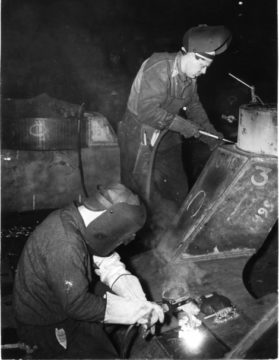Anne M. Wagner at nonsite:
 To think about the semantics of Smith’s work is above all to consider the labor that went into it, in the process informing how it was made. In this regard Smith’s story is well known. He famously welded steel, but also bent, pierced and cut it, lifted and placed it, often singlehandedly; in other words, he worked steel and iron directly, rather than turning to assistants to do the heavy lifting his art required.1 Yet despite Smith’s commitment to the bodily labor of making, the materials and procedures he used were then, and still remain, those of the military-industrial complex as famously defined by President Dwight D. Eisenhower in 1961.2 The artist, then aged 55, was only four years from his death. He learned to weld in the 1930s while employed by the auto industry, working for Studebaker, and a decade later made use of those same skills on a Schenectady (NY) assembly line, where he was as crucial as every other human cog in the effort to manufacture tanks for use in World War II.
To think about the semantics of Smith’s work is above all to consider the labor that went into it, in the process informing how it was made. In this regard Smith’s story is well known. He famously welded steel, but also bent, pierced and cut it, lifted and placed it, often singlehandedly; in other words, he worked steel and iron directly, rather than turning to assistants to do the heavy lifting his art required.1 Yet despite Smith’s commitment to the bodily labor of making, the materials and procedures he used were then, and still remain, those of the military-industrial complex as famously defined by President Dwight D. Eisenhower in 1961.2 The artist, then aged 55, was only four years from his death. He learned to weld in the 1930s while employed by the auto industry, working for Studebaker, and a decade later made use of those same skills on a Schenectady (NY) assembly line, where he was as crucial as every other human cog in the effort to manufacture tanks for use in World War II.
more here.
